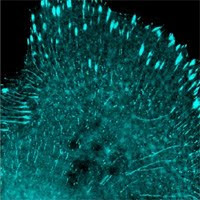Cancers undergoing therapies may develop resistance to treatment. Many current cancer treatments, such as cisplatin, function by creating DNA damage, particularly to fast-dividing cells, i.e., most cancer cells. These treatments may be rendered ineffective by DNA-damage response pathways. Cancer resistance to therapies may come from increased activity in nonhomologous end joining, decreased functions of mismatch repair, or reactivation of the Fanconi anemia (FA)/BRCA DNA-damage response pathway, etc. Ironically the loss of function of some of these DNA-damage repair factors may have partially caused the cancer formation in the first place. Regaining their functions in cancer cells possibly contribute to drug resistance. Molecules that disrupt FA/BRCA pathway or other DNA-damage responses could be used to help restore therapy sensitivity.
Like many proteins that function in DNA-damage repair complexes, FANCD2, a member of the FA pathway factor group, is targeted towards chromatin following damage to DNA in a process called foci formation. There have been recent studies that monitored the foci formation of GFP-FANCD2 in small molecule library screening and identified inhibitors to FANCD2 as candidates for a cancer therapy sensitizer. The assays can be improved in a number of ways. There are fluorescent proteins (FPs) that are much brighter than EGFP for increased sensitivity. For instance, the monomeric green FP mWasabi is about 2-3 fold brighter than EGFP, with narrower emission peak, and is more stable under acidic environment. The newly developed lancelet YFP (LanYFP, developed/introduced by Allele Biotech) is astonishingly 10 times brighter than EGFP. Since it has a longer excitation and emission wavelength, it should inherently have a better signal to noise/background ratio compared to EGFP because cells autofluoresce less in long wavelengths. The improved brightness would also help in this respect. The fold difference between foci and LanYFP background will be the same as EGFP, but the contrast will still probably be better because of less autofluorescent background and significantly higher fluorescence reading in foci.
Other factors that may be used as a screening target when fused to effective FPs may probably include:
1) Homologous recombination (HR)a. End Resection
MRN complex (MRE11, RAD50, NBS1)
CtIP, RPA, ATM, ATR, Exo1, BLM, RMI1, TopIIIa, DNA2, BRCA1
b. Synapsis
RAD51, BRCA2, PALB2, RAD51B, RAD51C, RAD51D, RAD51AP1, XRCC2, XRCC3, RAD54, RAD54B
c. DNA synthesis
DNA polymerase delta, PCNA
2) Nonhomologous End Joining (NHEJ)
Ku70/Ku80, DNA-PK, Ligase IV, XRCC4, XLF
3) Fanconi Anemia Pathway
FANCA, FANCB, FANCC, FANCE, FANCF, FANCG, FANCL, FAAP100, FANCM, MHF, FAAP24, FANCD2, FANCI, FAN1, FANCN, FANCJ, FANCM
- New Product of the Week 101110-101710:
- Promotion of the Week 101110-101710:
Original post: http://allelebiotech.com/blogs/2010/10/dna-repair-pathway-factors-in-cell-based-screening-for-restoring-patients%E2%80%99-sensitivity-to-cancer-therapies/




No comments:
Post a Comment